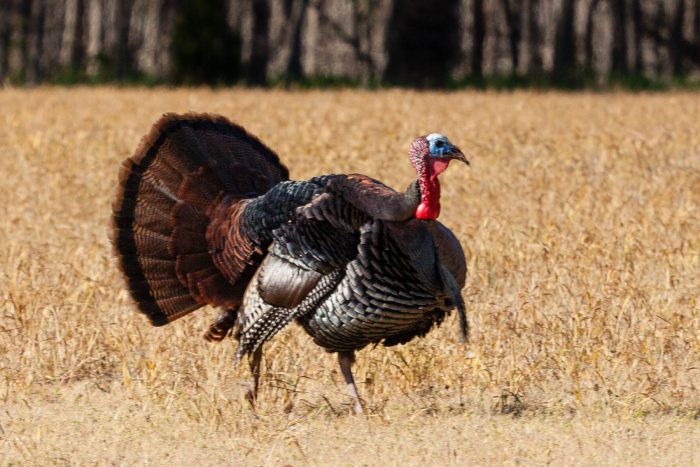Wild Turkey
Meleagris gallopavo
The wild turkey is a large, dark, ground-dwelling bird with a long neck and a fan-shaped tail and lives in open, wooded areas throughout the Chesapeake Bay watershed.
This section shows one large critter image at a time. Use the thumbnails that follow to select a specific image to display here.

This gallery contains a grid of small thumbnails. Selecting a thumbnail will change the main image in the preceding section.
Appearance
Wild turkeys have iridescent brownish or blackish plumage. Male turkeys have a bare head and neck. The neck is bluish-gray and the head is red, blue or white depending on the season. The head and neck are covered in hair-like feathers. Males have a fleshy, wart-like appendage called a caruncle between the eyes and a pink or red lobe of skin called a wattle that hangs from the neck or chin.
The breast feathers are tipped in black, and males have a tuft of rough, black feathers called a beard on their chest. The beard grows throughout the turkey’s life at a rate of about four inches per year. Adult male beards can be eight to 12 inches in length. The tail is large and fan-shaped tail with a brown tip. Short, rounded wings with black and white bars. Long, powerful legs that vary in color from pink to gray.
Female turkeys have a duller overall color than males, with gray heads and breast feathers tipped in white, gray or brown. Females usually do not have beards.
Feeding
Turkeys forage on the ground by scratching with their feet to uncover food; they feed two to three hours after dawn and before dusk.
Predators
Humans are the largest predator of wild turkeys. Bobcats, raccoons, eagles and owls also prey upon adult turkeys. Many types of birds, snakes and mammals feed on turkey eggs.
Flight
Turkeys can fly very swiftly; some have been recorded flying at speeds up to 55 miles per hour.
Voice
Males make a loud gobbling sound during courtship. They are known to make at least 15 different types of calls, including yelps and clucks.
Reproduction and life cycle
Turkeys mate in early spring. Males perform an elaborate courtship ritual to attract females. The ritual includes gobbling loudly, fanning out their tail, strutting around the females, and dragging their wing tips on the ground. Males can change the color of their head during breeding season to attract a mate and show dominance over other males.
Wild turkeys often locate their nest at the base of a tree that offers overhanging cover. Females begin laying one egg per day in mid-April. They lay a total of approximately 12 eggs, which they incubate for about four weeks. Eggs usually hatch around the first week of June. Males do not help care for the young.
Young chicks follow their mother out of the nest within one day of hatching. They quickly learn to feed themselves, and can fly by the time they are eight days old. Young males stay with the female through autumn, and young females stay until the following spring.
Wild turkeys may form bands of 30 or more birds, with groups sometimes becoming even larger in winter. On average, wild turkeys only live less than two years. However, some have been known to live as long as 13 years.
Did you know?
- Male turkeys are called “toms” or “gobblers” and female turkeys are called “hens.” Juvenile males are called “jakes.”
- Wild turkeys are very similar to domesticated turkeys, except wild turkeys are smaller, slimmer and have a longer neck and body.
- Approximately five percent of female turkeys have beards.
- Spurs on the back of males’ legs grow throughout the turkey’s life. Scientists and hunters use spurs to estimate a turkey’s age.
- Wild turkeys have excellent eyesight and hearing, and can run very quickly.
Sources and additional information
- Animal Diversity Web: Meleagris gallopavo – University of Michigan Museum of Zoology
- All About Birds: Wild Turkey – The Cornell Lab of Ornithology
- NatureWorks: Wild Turkey – New Hampshire Public Television
- Meleagris gallopavo – U.S. Forest Service
- Wild Turkey Facts – Virginia Department of Game & Inland Fisheries
